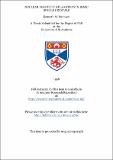Files in this item
Nuclear magnetic relaxation in ionic single crystals
Item metadata
| dc.contributor.advisor | Andrew, E. Raymond (Edward Raymond) | |
| dc.contributor.author | Swanson, Kenneth M. | |
| dc.coverage.spatial | 128 p. | en_US |
| dc.date.accessioned | 2018-06-28T10:39:42Z | |
| dc.date.available | 2018-06-28T10:39:42Z | |
| dc.date.issued | 1958 | |
| dc.identifier.uri | https://hdl.handle.net/10023/14700 | |
| dc.description.abstract | It has been known since 1946 that energy can be absorbed from a radiofrequency field by the nuclear spins in bulk material placed in a uniform magnetic field. For this absorption of energy to be a continuous process it is necessary for the spins to have some thermal contact with the surrounding lattice, so that they can pass on the absorbed energy and then take part in further absorption. In general a nucleus can exchange energy with the lattice by means of interaction between its magnetic dipole moment and fluctuating magnetic fields supplied by the lattice, or by interaction between the electric quadrupole moment of the nucleus and fluctuating electric field supplied by the lattice. Either or both of these interactions can provide the relaxation mechanism which allows the nucleus to lose to the surrounding lattice the excess energy gained from the applied radiofrequency field in nuclear magnetic resonance absorption. This thesis describes a method of showing experimentally which of these interactions is dominant in providing the relaxation mechanism in cases where either mechanism can operate. | en_US |
| dc.language.iso | en | en_US |
| dc.publisher | University of St Andrews | |
| dc.subject.lcc | QC765.S8 | |
| dc.subject.lcsh | Magnetic materials | en |
| dc.title | Nuclear magnetic relaxation in ionic single crystals | en_US |
| dc.type | Thesis | en_US |
| dc.type.qualificationlevel | Doctoral | en_US |
| dc.type.qualificationname | PhD Doctor of Philosophy | en_US |
| dc.publisher.institution | The University of St Andrews | en_US |
This item appears in the following Collection(s)
Items in the St Andrews Research Repository are protected by copyright, with all rights reserved, unless otherwise indicated.

